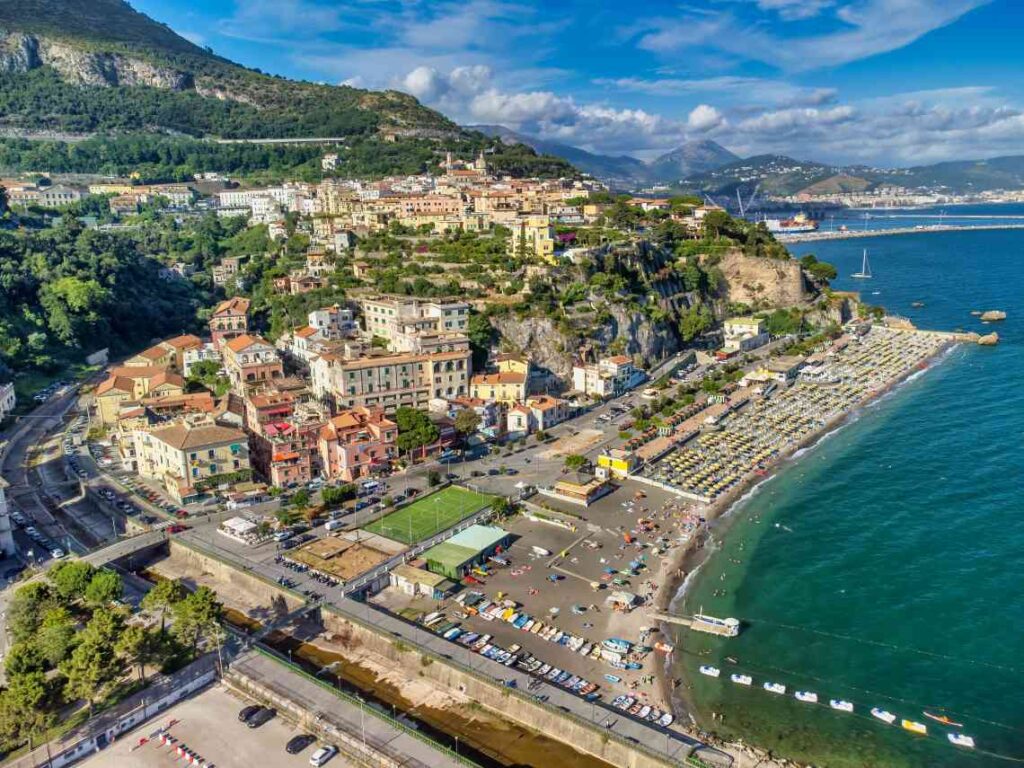If you are thinking of taking a vacation to discover the Amalfi Coast and its villages, get ready to immerse yourself in the views of one of the most beautiful areas in the world. The Amalfi Coast is famous for its natural beauty, but also for its culture, tradition, history and splendid architecture. It doesn’t matter if you want a romantic weekend or a family vacation, this region of Campania knows how to make everyone fall in love. And we have a variety of beautiful spots for you to visit.
- Where is the Amalfi Coast?
- When should I visit the Amalfi Coast?
- How to get around on the Amalfi Coast
- The Amalfi Coast: The Villages
Where is the Amalfi Coast?
This famous Coast is in the Italian region of Campania, precisely in the province of Salerno. It overlooks the Tyrrhenian Sea, which makes it a tourist destination since ancient times. Its uniqueness allows it to be a reference point of great natural and cultural value. Considered one of the most beautiful areas in the world, the Amalfi Coast seems like a collection of precious gems set in rocks. No wonder UNESCO has awarded the entire area the title of World Heritage Site since 1997.
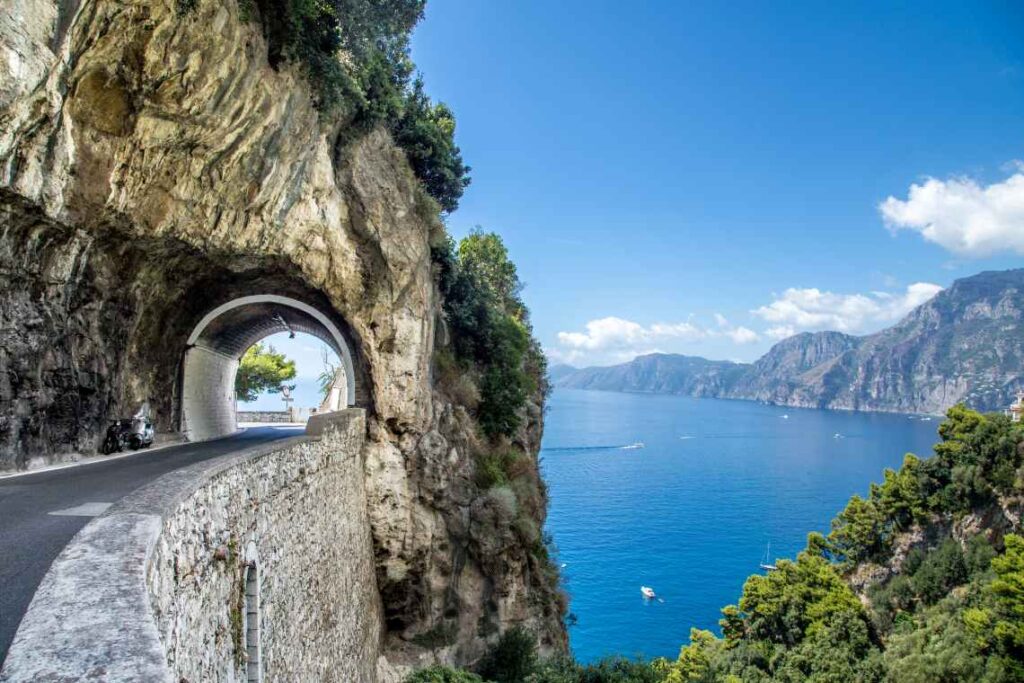
When should I visit the Amalfi Coast?
It’s not always possible to choose when to go on vacation. However, if you have the possibility to be flexible, the best period to visit the Amalfi Coast is between April and June. Spring brings an explosion of scents and colors, framed by a warm sun that illuminates the wonders of the towns of the Amalfi Coast. You can enjoy walks on the shore and the first dip in the sea of the summer season, before the hordes of tourists and the unbearable temperatures of summer arrive. In addition, between May and June the cost of accommodation and some activities are generally lower than in the high season months. September is also a good month to visit the coast. The weather is still mild, but the tourist crowds have almost completely thinned out, and the towns seem to be regaining their tranquility.
If you are an incurable romantic, during the winter months the Amalfi Coast will give you an incredible charm with less crowded streets, lulled in the distance by the sound of the sea. Even in winter, the coast knows how to entertain you with many activities and attractions, but you also need to keep in mind that many bars and restaurants are closed. Moreover, despite the mild climate, from the beginning of November through mid-March, rain is very frequent.
How to get around on the Amalfi Coast
Before figuring out how to get around, you need to understand how you will arrive in the area. If, for example, you are arriving by train, it is likely that you will get off at Salerno station. From here you can choose between two alternatives: the public transportation of the bus company Sita SUD, or the ferries. If you arrive by plane, it is likely that you will land in Naples. From here, you can use buses, ferries and hydrofoils to get to the coast. Or use the more expensive solution and take a private plane.
Is it possible to visit the Amalfi Coast by car? Yes. You can either travel in your own car or rent one in Naples or Salerno. The road that takes you to the Amalfi Coast is full of curves and in the high season months can be quite busy. Make sure that the hotel where you are staying has a parking lot where you can leave your car, because parking lots are not common and can be expensive. Despite this, renting a car will give you all the flexibility you need to not miss anything in one of the most beautiful places in Campania.
The Amalfi Coast: The Villages
The Amalfi Coast is the stretch of Tyrrhenian Sea bordered on the west by Positano and on the east by Vietri Sul Mare, and it includes some of the most interesting views of southern Italy. Here nature seems to have maintained its grandeur. It mixes with ease with what man has built over the centuries, giving us unique views. But what towns on the Amalfi Coast are worth visiting? How do you decide which stops to make on your road trip? Follow us on this journey to discover the towns of the Amalfi Coast in geographical order, from west to east.
- Sorrento
- Positano
- Praiano
- Furore
- Conca dei Marini
- Amalfi
- Atrani
- Ravello
- Scala
- Maiori & Minori
- Tramonti
- Cetara
- Vietri sul Mare
Sorrento
Some of you might notice right away that Sorrento is not really part of the Amalfi Coast. So much so that it is often not included in the itineraries dedicated to it. Sorrento is in fact in the province of Naples, overlooking the gulf of the same name, and is the most famous town on the Sorrento Coast. If we wanted to be fussy, our road trip on the Amalfi Coast should not start from here. However, if you have the possibility and the time, we strongly suggest you add Sorrento to your Campania road trip, as it’s only 18 kilometers (11 miles) from Positano.
This small village overlooking the sea hides many gems among its streets. In the historical center, for example, you can visit a cloister dating to 1300 or the Tasso square, dedicated to the eponymous poet who was born here. The Bagni Marina Piccola makes up one of the most unique beaches in the world. It’s are in the city center and are made of piers on stilts that go straight into the sea. If you are looking for a more private beach, we recommend the Bagni della Regina Giovanna. Although it is not easy to reach, your efforts will be rewarded by an indescribable beauty.
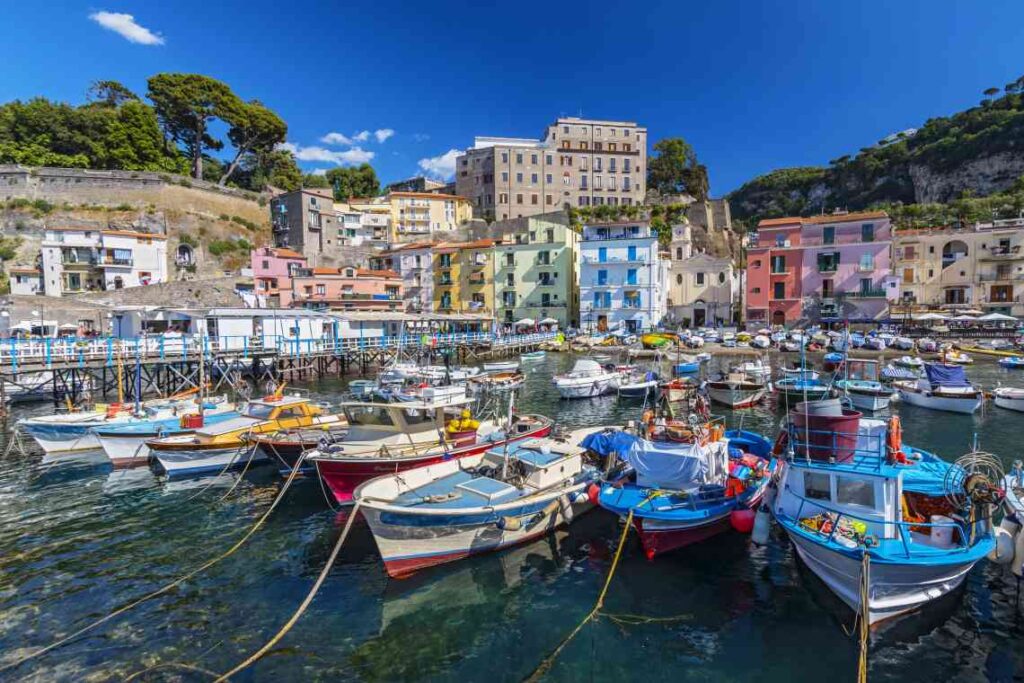
Positano
Positano is one of the most famous towns on the Amalfi Coast. This seaside village rises between Punta Germano and Capo Sottile. Set on a rock, its historical center develops vertically with houses leaning against each other and narrow streets that climb the coast. The village is overshadowed by the Collegiate Church of Santa Maria Assunta. Its colored majolica dome is one of the symbols of the Coast.
Going down to the shore, you’ll have your choice of where to go to sunbathe. Among the many places is the main beach of Marina Grande, the small and wild beach of Laurito and the beach of Arienzo, called “the beach of the 300 steps”, because of the long staircase you have to climb to reach it. From Positano there are daily excursions to the Li Galli Islands, Marina del Cantone, the Bay of Ieranto and Capri. Do not forget to dedicate an afternoon to shopping, as Positano Fashion is known and appreciated worldwide. If you love hiking, from Positano you can walk along the famous Path of the Gods. The trail connects the towns of Agerola and Positano and is quite easy to walk. With a drop of 600 meters downhill, the hike has an average duration of about 5 hours. We do not recommend it for people who suffer from vertigo or are afraid of heights!
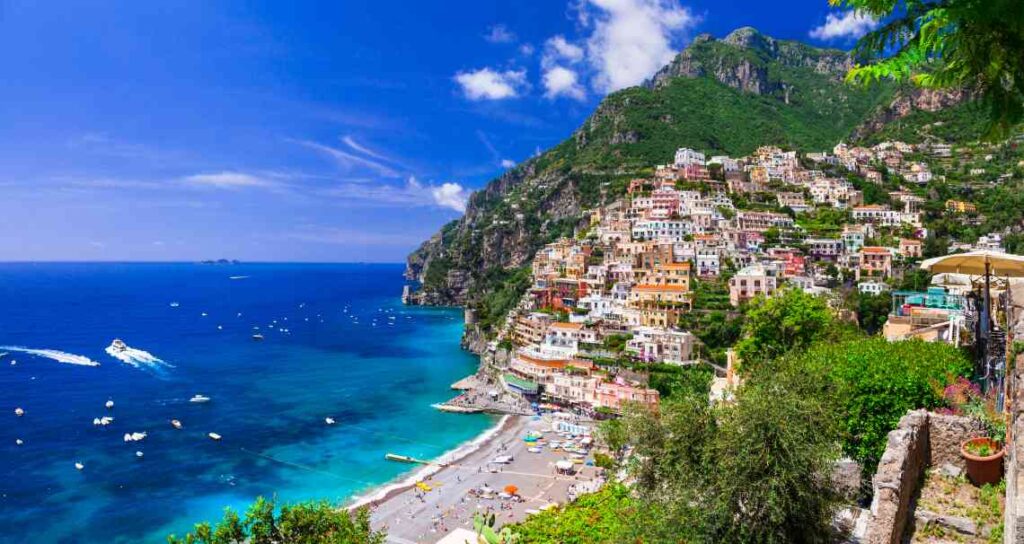
Praiano
If you are sentimental, we have arrived in the location of the most romantic sunsets. Praiano, in fact, is perhaps one of the most beautiful places on the coast. This small port, located on a natural landing place, has managed not to be overwhelmed by mass tourism, maintaining an irresistible charm that makes it one of the most beautiful villages in the area. Among olive trees, oleanders and pines, Praiano overlooks the sea with its narrow streets that turn into steep stairways and its pastel-colored houses. Another characteristic element of this ancient seaside village are the votive shrines decorated in majolica pottery designs.
If you stop in Praiano you must visit Cala la Gavitella, which is not the most beautiful beach on the Amalfi Coast, but certainly one of the most famous. Its name comes from its position that allows it to be kissed by the sun from dawn until sunset. In addition to a splendid view of Capri and Positano, in this small bay you can dive into the Fontana dell’Altare, a natural pool located at the mouth of a cave.
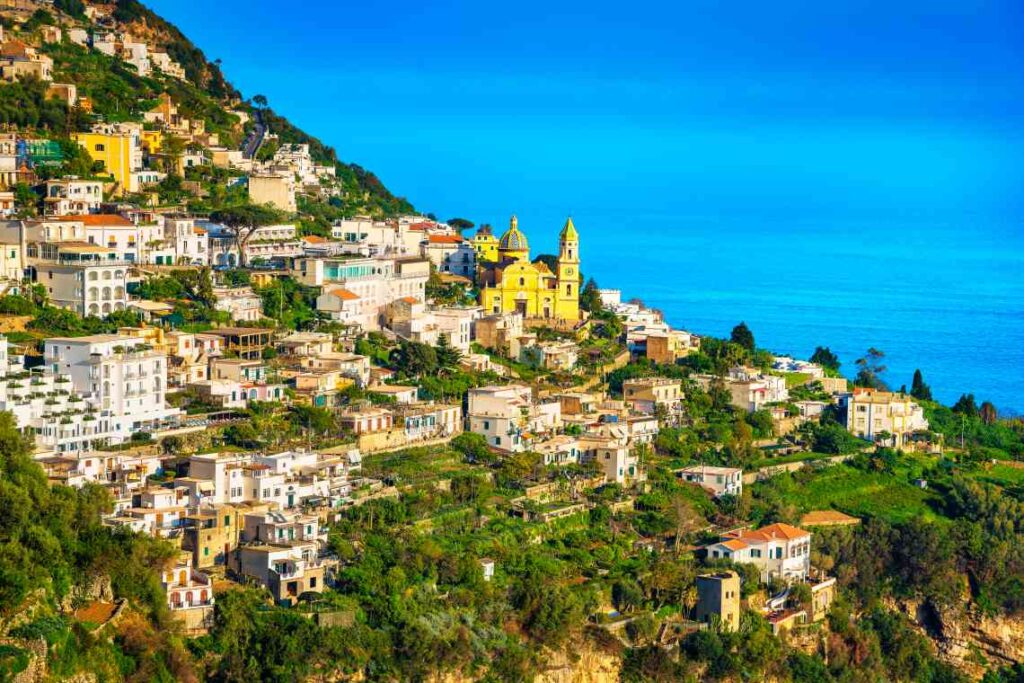
Furore
The next place of the Amalfi Coast to visit is Furore. Considered one of the most beautiful villages in Italy, Furore is set at the foot of Monti Lattari. The houses of the village emerge among the rich vegetation and the rocks of Scosciese. It owes its fame to its fiordo, a high rock that overhangs the sea. The sun peeks out only in the early afternoon hours, allowing the area to maintain a cool climate even in summer.
Every year, in July, the best divers from all over the world come to Furore to take part in a diving competition from the village’s most famous bridge (28 meters from the sea). The famous beach of Fiordo di Furore is only 25 meters long. It is not possible to get there by car. It can be reached through a path in the rock which starts from the bridge over the Fiordo, on the Amalfi state road. But Furore is not only beaches and sea. The village is renowned for being the home of Fiorduva, a wine famous throughout the world. Stop in one of the town’s restaurants to taste a glass.
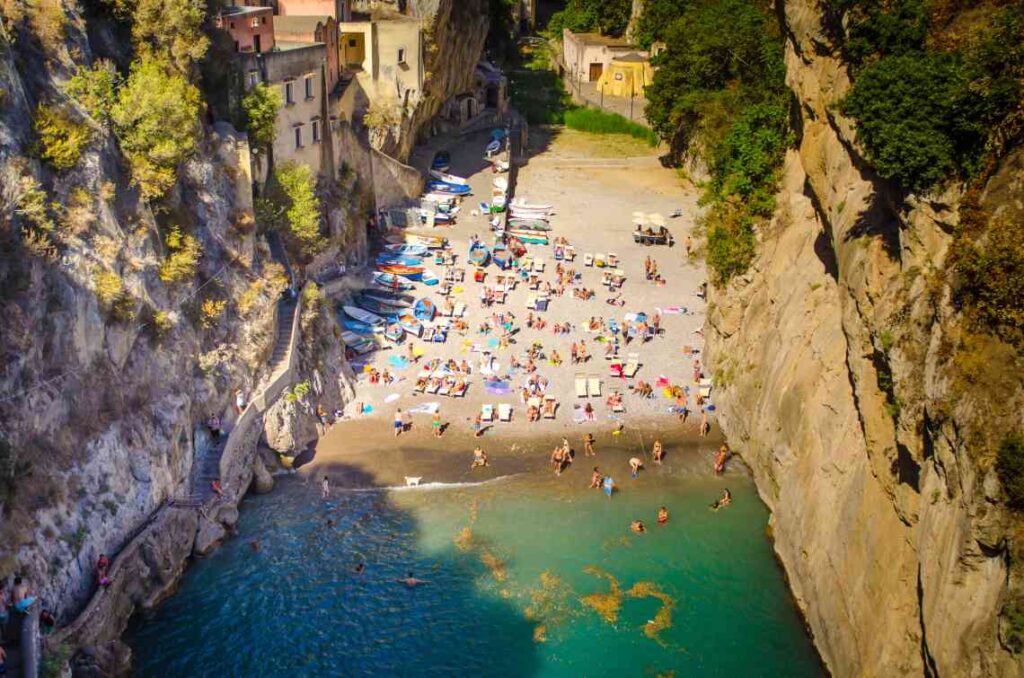
Conca dei Marini
Let’s continue our tour of the Amalfi Coast with the town of Conca dei Marini. Although more of a town, Conca dei Marini is famous for being the fourth smallest municipality in Italy by surface area. It owes its name to its unique shape, and is built on two levels. In the lower part, where the warehouses of those who fished the waters once stood, there are houses on the seashore that are reflected in the water. At the top, amid the thick vegetation of olive and lemon trees, there are the little houses made of white limestone, connected by a network of small streets and stairways.
While here, you cannot miss the Emerald Cave, a cavern that takes its name from the color of the reflections that the water takes inside. The cave can be visited all year round: from April to October, from 9am to 4pm and from November to March from 9am to 3pm. The tour takes place by rowboat and lasts about 15-20 minutes. You will be accompanied by an experienced sailor who will explain the history of the cave and its characteristics.
If you are fond of diving, the depths of the Emerald Grotto hide a real gem: the white ceramic nativity. Placed there for the first time in 1964 by coastal residents to honor those who died at sea, the nativity has since been replaced several times. In 1987 and then in 1992, the statues were changed due to corrosion from salt spray. Now the statues are made of glass resin, a more weather-resistant material.
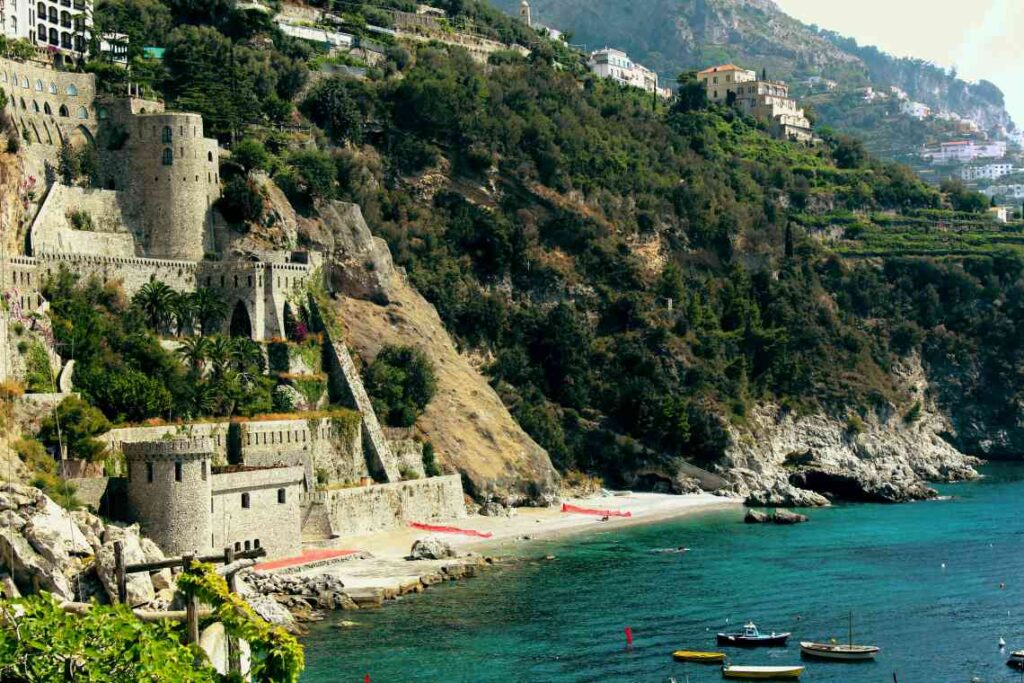
Amalfi
Amalfi and its surroundings are an unmissable stop on your tour. This namesake of the region is the largest city on the Amalfi Coast and is the oldest Italian maritime republic. Together with Positano, it is probably the city that attracts the most tourists to the entire Amalfi Coast.
Besides its beauty, Amalfi is rich in history. For years this town has been the heart of the political and economic activities of the area. It also preserves the artisan traditions of lemon cultivation and paper making. Explore its characteristic streets and alleys, the arsenals and the Paper Museum. The main square houses the Cathedral of St. Andrew, a building in Arab-Sicilian style. It is located at the end of a long flight of stairs and dominates the entire city from above. There is also natural beauty to be found. In addition to many paths with breathtaking views, we recommend you visit the Vallone delle Ferriere, a nature reserve of great charm. If you want to appreciate the sea, we recommend you choose one of the most famous beaches such as Duoglio, Grande and Santa Croce.
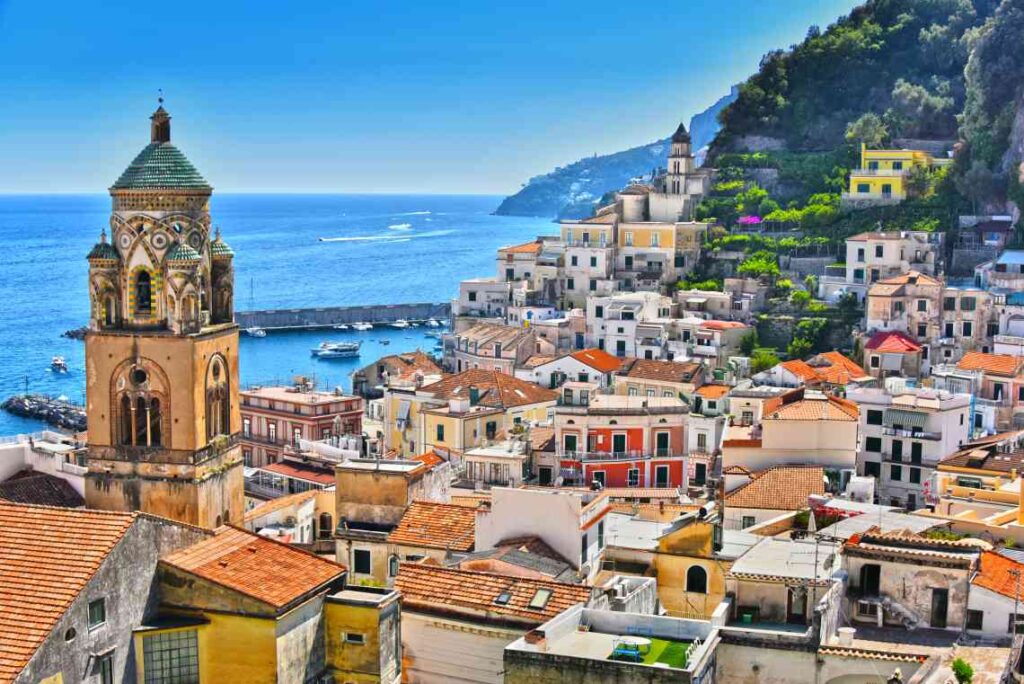
Atrani
Among the towns near Amalfi to see, there is Atrani, the smallest municipality of the whole Italian territory. Geographically it’s almost part of the city that gives its name to the coast, and this village stands on a small strip of land called “Valley of the Dragon River”, squeezed between Mount Aureo and Mount Civita.
Although its history is partly shrouded in mystery, and because of the famous eruption of Mount Vesuvius in 79 A.D., which made an accurate analysis of its most ancient monuments impossible, Atrani has been able to keep its ancient character of a small fishing village intact over the years.
Let yourself be enchanted by the beauty of its small houses leaning against each other, the stairways, courtyards and alleys that climb up the rock. Some buildings directly overlook the beach, while others face the small square where the Church of San Salvatore and the Stone Fountain stand.
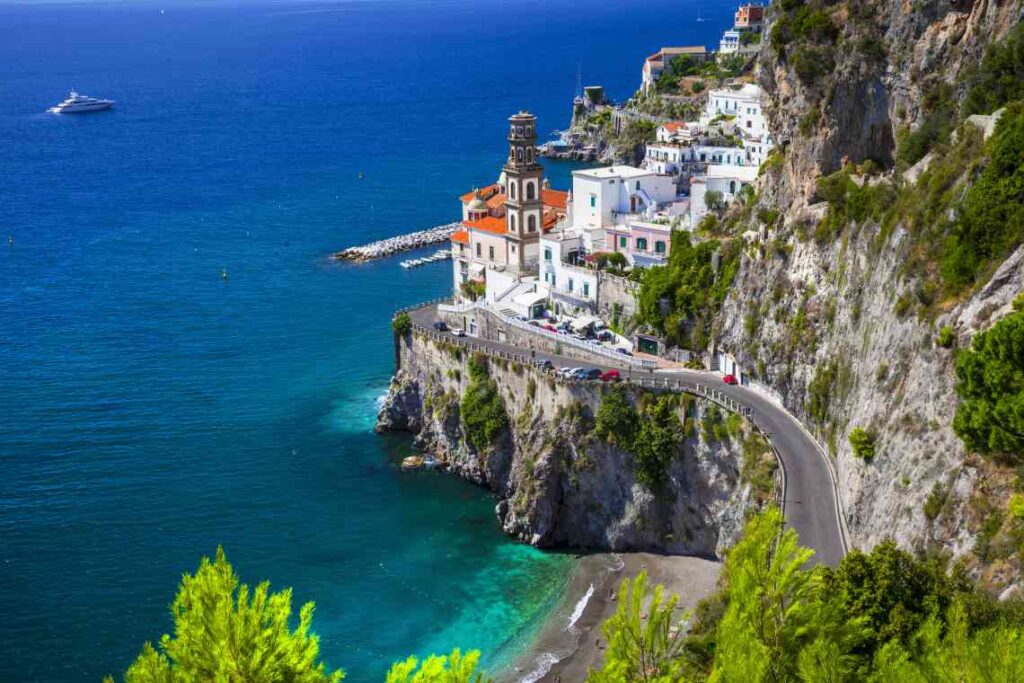
Ravello
Now we’ll move a little away from the coast to the village of Ravello, which doesn’t directly overlook the sea. This charming town above Amalfi, is in a rather elevated position compared to the coast. Do not be intimidated, Ravello remains one of the most suggestive destinations on the entire Amalfi Coast. Famous for having hosted illustrious personalities such as George Byron and Richard Wagner, Ravello is a gem set in nature. Here there are many nature trails that will allow you to appreciate incredible views. Far from the chaotic bustle of tourists, it is home to churches of medieval charm and garden-villas that stand out with their beauty against the blue sky.
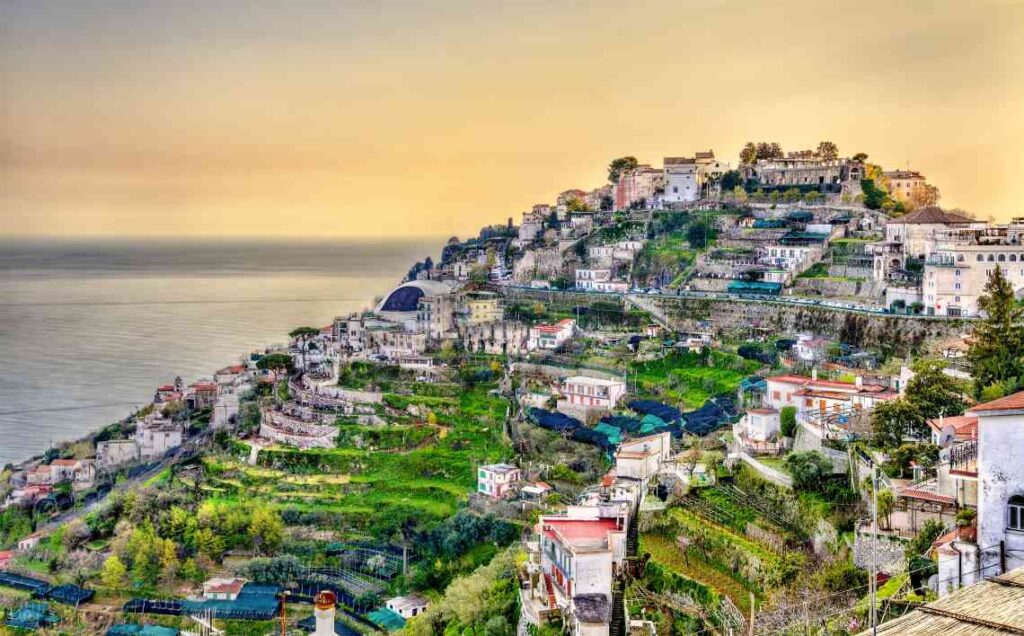
Scala
Let’s go further inland. Immersed in the green, among olive groves and vineyards, right in the center of the chain of Lattari mountains rises Scala, a small village 450 meters (about 1,476 feet) above sea level. Thanks to its elevated position, Scala offers views of stunning landscape. In fact, there are many excursions where you can admire breathtaking views of the sea. If you are a nature lover, we recommend a visit to the Valle delle Ferriere State Natural Reserve, a charming area in the mountains shaped by the course of the river Canneto, where you can admire the local flora and fauna.
Founded in the 4th century by Pisan soldiers, Scala was also a district controlled by a bishop. Precisely because of its religious importance, the town’s architecture and character were greatly influenced by the aesthetics of the buildings of worship. This is an ancient and noble village, rich in art and culture, set between the sea and the mountains. It’s the perfect place for those who want to spend a few days in complete tranquility.
Maiori & Minori
It’s impossible to talk about Maiori without mentioning its sister Minori. The two villages, just over 1 mile from each other, are united by the presence of the river Reginna that, before flowing into the sea, divides in two, characterizing the two countries.
Besides the incredible architectural and artistic beauty present in the village, Maiori also enjoys an incredible natural heritage. To better appreciate its charm, we suggest you walk the Sentiero dei Limoni (Lemon Path). It is considered one of the most beautiful trails in Italy. It connects Maiori and Minori along the mountainous coast, passing through the Village of Torre. If you love the sea, the beach of Maiori is the longest of the entire Amalfi Coast (about 1 km, or 0.6 miles). This beach is characterized by sand of volcanic origin.
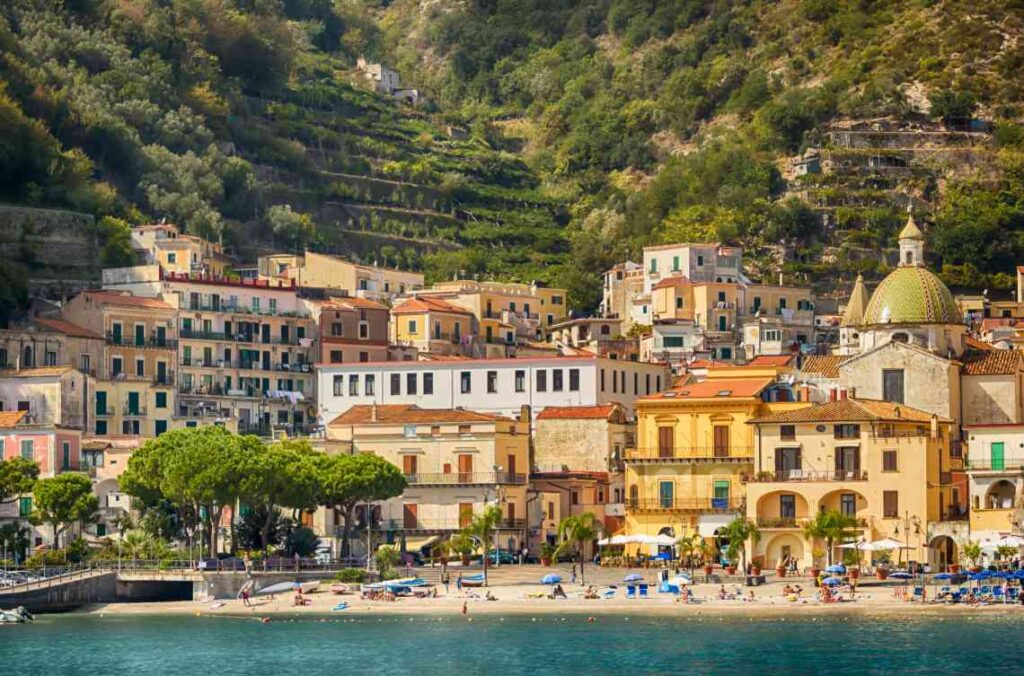
Minori is a small corner of paradise with less than 3,000 inhabitants. Bathed by the sea on one side and framed by the hills and the local vegetation on the other, this village has been a coveted tourist destination since the age of Imperial Rome. In the course of history, Minori has changed its urban formation several times, without ever losing its spirit of coastal town, where tradition and culture coexist with the beauty of nature.
This village is also known as the “City of Taste”, for its gastronomic tradition. If you are passing through Minori, you must try the ndunderi, a type of fresh pasta similar to gnocchi, which is rethought in a thousand different recipes every day. You should also try the lemon-based products, such as the lemon tagliolini or the citrus and shrimp risotto. There are also a variety of baked goods, and we suggest you try the ricotta and pear cake.
Tramonti
After some time on the coast, it’s again time to get away from the shore. As the name suggests, Tramonti is located “between the mountains,” where nature is the undisputed queen. The dense forests of local vegetation and wildlife frame this quiet little village. For those who want to take a break from the beaches, and enjoy nature away from mass tourism, this is the right place.
Tramonti is a city with a strongly religious soul. In this small village you can find more than 15 churches as well as a convent of Franciscan friars. For lovers of nature and hiking, we recommend the 13 Churches Trail. The 13 churches come from the 13 hamlets in which Tramonti is divided, even if in reality this circular path touches only 11. It is 14 km (8.7 miles) long with an uphill difference in height of 527 meters (1,729 feet), hiking this path will take about 5 hours.
Cetara
Cetara is a small village that rises up the slopes of Mount Falerio. The historical center, which contains many monuments, is in a valley and expands downhill to the sea, where it forms a small flat area. Here you will find characteristic colorful houses that are reflected in the water.
Its maritime tradition is inherent in its origins. The name Cetara derives in fact from Cetaria, or “tonnara”, which are tuna-fishing nets. Not everyone knows that this village is famous for the quality of tuna caught by local fishermen. Besides this, the town is also famous for the quantity of anchovies fished. Tuna and anchovies are consequently the basis of many recipes and typical products, such as linguine with anchovies. You can also try fried fish and other dishes from the sea.
This village is characterized by having small beaches and coves scattered along the coast. The most famous is certainly the inlet or beach of the lovers of Cetara. This little corner of paradise is located in a ravine on the coast, surrounded by rocks overlooking the sea. The surface is small and can accommodate very few people. Unlike other towns on the coast, Cetara has not developed mass tourism. Therefore, it is perfect if you are looking for a village where you can enjoy flavors and traditions without worrying about the hordes of tourists.
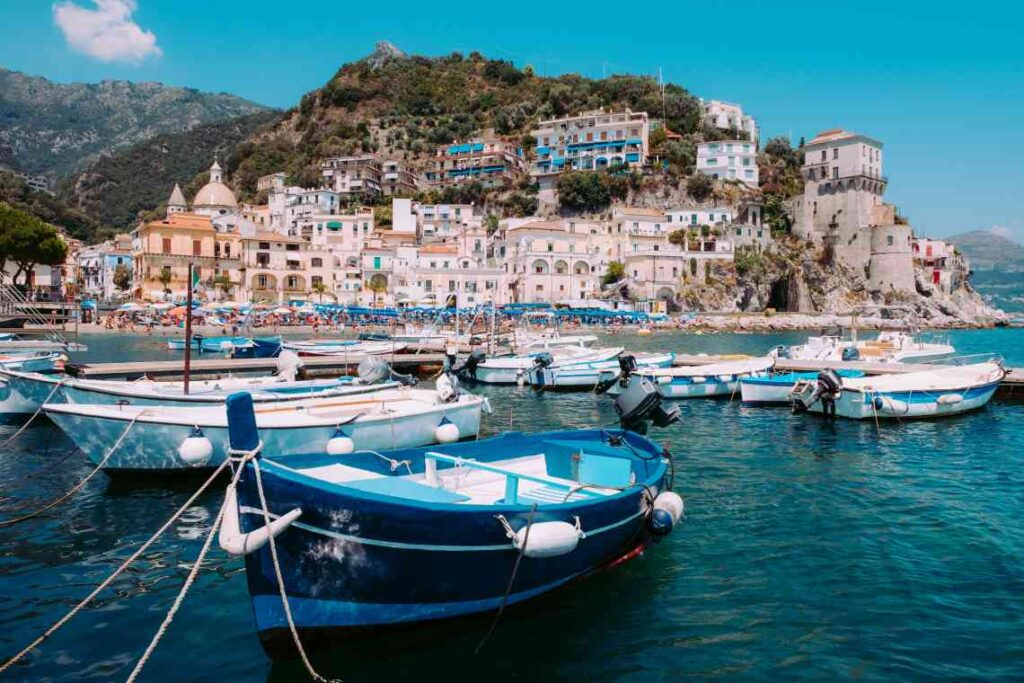
Vietri sul Mare
We have arrived at the last stop of our Amalfi Coast vacation. Or first if you decide to start from Salerno. On a do-it-yourself Amalfi Coast tour, you decide.
Although the tradition of ceramics can be found throughout the coast, Vietri sul Mare is the undisputed home. You’ll notice it immediately walking along Corso Umberto I, the main street of the city. Here the numerous artisan stores expose tiles, plates, vases and ceramics of every kind. Besides ceramics, Vietri is also famous for the “pezze di Positano”, colored fabrics in the Provencal style.
If you love nature, you can’t miss Croce Park, a World Wildlife Fund oasis donated by the family of Benedetto Croce. It is located at the foot of Mount Falerio and is made of Mediterranean scrub on one side, and terraces cultivated with vines and fruit trees on the other. Here you can admire the typical fauna and flora of the region.
